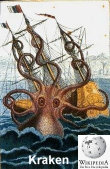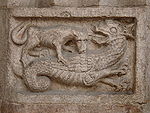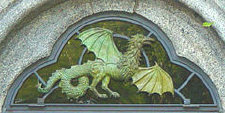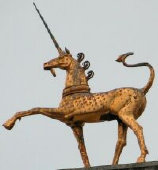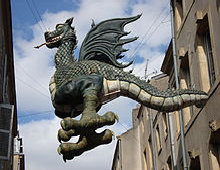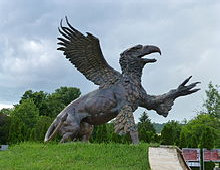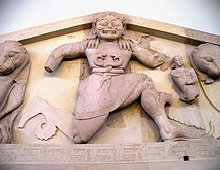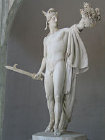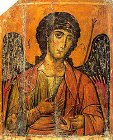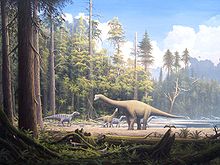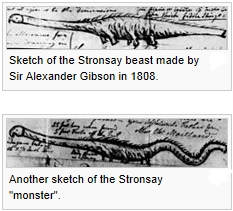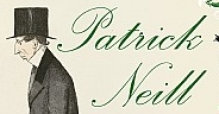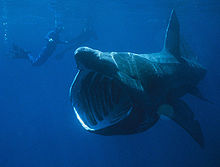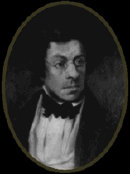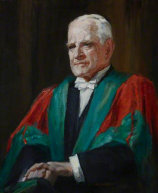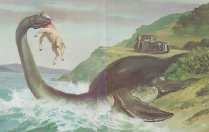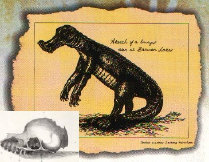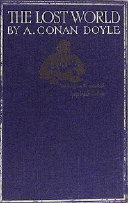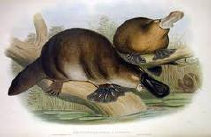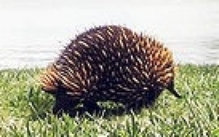
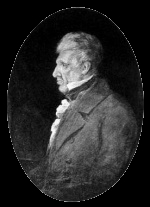



Man is incurably romantic, exceedingly prone to exaggeration, and credulous in the extreme. In the domain of natural history we find
some astonishing manifestations of these engaging human qualities, and the mere enumeration of the various mythological creatures
which have been described, pictured and firmly believed in at one time or another, would fill several pages. The kraken, wyvern, cockatrice,
hydra, basilisk, unicorn, dragon, griffin, gorgon and a host of others, strange in appearance and generally deadly in their qualities,
have played so an important a role in tradition, folklore, and fairy tale that they are almost as real to us Santa Claus himself.
It may be accepted that these “monsters” were not evolved out of man’s inner consciousness, but there has always been some basis,
however flimsy, upon which fancy could build. Thus many myths originated in the tales of strange beasts which early European travellers
related on their return from journeys into previously unknown lands. They were naturally inclined to magnify the perils they had escaped,
and to astonish the stay-at-homes by “improving” on the strange creatures they had seen in distant countries. And they were materially
aided by the imaginative powers of these stay-at-homes. Thus the unicorn myth is apparently based on an off-hand description of a
rhinoceros as a creature resembling a horse with a horn on its face. Later, when the long spirally twisted tusk of the narwhal was
brought back from artic seas, it was hailed as the veritable horn of the unicorn, and, when an artist depicted a horse with a horn
on its forehead, the unicorn was firmly established, and is now familiar to us all as a heraldic device and one of the supporters
of the royal arms.
So the dragon, which in one form or another is one of the oldest and most widely spread
of the mythical creatures, probably originated in stories of the pythons of tropical Asia and Africa, great snakes which may attain
a length of twenty-five feet or more, and which on account of their great strength, sinister appearance and dangerous character, were
regarded with superstitious awe by the primitive peoples who inhabited these regions. Add wings and clawed limbs to a python in order
to make it more fearsome and we have the makings of a first-class dragon, a worthy antagonist of the heroes of old, from Hercules
and Perseus to St. Michael and St. George.
Now that we are more fully acquainted with the lands of the globe
and their animal denizens, we are more critical regarding traveller’s tales, consequently most of the mythical monsters of the Middle
Ages have been relegated to the limbo of things that are not. Although there are many kinds of land animals yet to be discovered and
described, they are mostly of small size, and it is safe to say that there is no mammal, bird, or reptile of large dimensions and
unusual structure which is entirely unknown, and which would not fall naturally into some well recognised group. Yet superstition
and belief in the bizarre and the marvellous die hard, and popular fancy can still be tickled by rumours of the existence of some
gigantic unknown animal, usually supposed to be a survival from prehistoric times, when, as we know, strange creatures, quite unlike
any present-day animal, did exist. But we must not forget that to one of the long-extinct reptiles of the Mesozoic period, which lived
and died millions of years ago, the existing fauna, including man, would also be passing strange.
The residual
fabulous creatures are usually inhabitants of the ocean, or of lakes and rivers, for these may be supposed to show themselves but
seldom, and in a furtive manner, so that the little knowledge we do obtain in brief glimpses does not fetter our imagination in the
slightest. Such aquatic “monsters” are the great sea serpent of every sea, the water kelpie of Scotland, and the bunyip of Australia—and
the greatest of these is the sea serpent.
THE SEA SERPENT.
Erik Pontoppidan, the learned Bishop of Bergen,
who wrote a “Natural History of Norway” in 1755, gave pontifical authority to the sea serpent, and also described the kraken, which
is now known to have been a large squid. Since Pontoppidan’s day alleged sea serpents of large size and fearsome appearance have been
reported from time to time in many different places, but the descriptions by eye-witnesses vary so much that there are several different
kinds of sea serpent.
One of the best authenticated is that which was seen from the deck of H.M.S. Daedalus,
off the coast of Africa, in 1848. A report by Captain Peter McQuhae described it as at least sixty-feet in length, with a head which
was “without any doubt that of a snake”. It had no fins but “something like a mane of a horse or rather a bunch of seaweed, washed
about its back”. A sketch of this “serpent”, made immediately after it was seen, has been several times reproduced, and depicts a
creature resembling a large snake or eel.
In May, 1917, Captain F. W. Dean and several of the officers and
men of H.M.S. Hilary saw a “sea serpent” about seventy miles south-east of Iceland. The creature passed at a distance of about thirty
yards, and lifted its head once or twice as if looking at the ship. “Its head was black and glossy, with no protrusions such as ears,
etc., in shape about that of a cow . . . the top edge of the neck was just wash, and it curved to almost a semicircle, as the creature
moved its head as if to follow us with its eyes. The dorsal fin was a black equilateral triangle which rose at times till the peak
was estimated to be four feet above the water.” [Nature, March 22, 1930, p. 469.]
The poor thing was used
as a target for anti-submarine practice at about 1,200 yards range, and a direct hit having apparently been scored, it disappeared,
leaving no trace. A few days later the ship was torpedoed and sunk, and all records regarding the “sea serpent” were lost.
Australia, too, has records of sea serpents, and its latest appearance on the South Coast of New South Wales in 1930 will be fresh
in the memory of our readers. The Bellambi Reef specimen was seen at fairly close quarters by some courageous fishermen who rowed
near it, and from their description Mr. D. G. Stead concludes that it was probably a Pike Whale. [Stead : Giants and Pigmies of the
Deep, Shakespeare Head Press, 1933, p. 83.] A day or so later another monster was reported from Scarborough a few miles north of Bellambi
Reef. In this case the creature was seen by various reliable observers and was described as resembling a huge snake eighty or ninety
feet long.
AN ORCADIAN SEA SERPENT.
But the most convincing of all sea serpents is that which in the autumn
of 1808 was, during a gale, thrown ashore in Rothiesholm Bay on the island of Stronsay, Orkney, for in this case it was not a question
of merely viewing the creature from the deck of a ship or from the shore, its body was actually available for post mortem examination,
and a pretty controversy arose over its mortal remains. Its subsequent history, too, is not without interest, showing as it does that
evidence given in good faith by reliable but inexpert witnesses may be utterly misleading, and that conclusions based thereon are
quite false. The whole story conveys a useful lesson and warning.
Statements by various people who saw the
animal after its stranding were made on affidavit before Dr. Robert Groat, physician in Kirkwall, and Malcolm Laing, M. P., well known
from his historical writings. According to the depositions the animal had a snake-like body fifty-five feet in length, a sort of crest
or mane along its back, and three pairs of legs. Patrick Neill, a naturalist of some repute, described it before the Wernerian Society
of Edinburgh as a sea serpent similar to that of Bishop Pontoppidan. The depositions were forwarded to Sir Joseph Banks, and by him
submitted to Everard Home, a distinguished anatomist and ichthyologist, who was also able to obtain from Malcolm Laing some portions
of its body. From a study of the depositions and such fragments as he was able to examine, Home concluded that the supposed sea serpent
was a Basking Shark (then called Squalus maximus), one of the largest of the shark family and one which frequents the Orkney Islands.
Dr. Barclay of Edinburgh disputed this opinion, and concluded with the caustic remark, “if the characters of genus and species be
to rest on such vague and conjectural evidence as that which proves this animal to be a Squalus, we may as soon get aquainted with
nature through the dreams of cosmogony, or the tales of a tub, as through the observations of natural history.” [Memoirs of the Wenerian
Natural History Society, 1, 1808-1810, p. 429.]
Dr. Barclay himself is non-commital as to the exact nature
of the animal, but refers to it as a cetaceous fish!
The argument assumed almost international importance,
and varying views as to the nature of the monster were expressed. Oken, the learned German scientist, thought it might be a “rabbit-fish”
or Chimæra, Dr. Hibbert regarded it as a sea serpent, and Professor John Fleming of Edinburgh was inclined to agree with him. The
German zoologist Rathke thought it might be a relative of the extinct plesiosaur.
Part of the Orcadian monster
was given to Lady Byron (of all people), and part to the Natural History Museum, and Professor J. Ritchie, University of Aberdeen,
formerly Keeper of Natural History in the Edinburgh Museum, has re-examined these, and in the Times of December 16, 1933, he publishes
his conclusions, which support Home’s identification of the animal as a Basking Shark, the “mane” being the frayed-out fin rays, the
legs consisting of the remains of twp pairs of fins and the claspers. In justice to the honest islanders it must be remembered that
the fish had been dead for several days before its body was critically examined, that it was largely decomposed, and the sea birds
had been feeding upon it in great numbers.
THE LOCH NESS MONSTER.
This creature, whatever it may be, has for
months past created almost as much interest and speculation as disarmament or test cricket. Some animal which is not in its usual
environment has certainly been seen in this Scottish Loch, and we have the usual crop of conflicting accounts of its size and appearance.
Its length has been variously given as ten, thirty, and sixty feet, it has presented itself as a series of humps recalling the sea
serpent, as a huge amphibian or salamander-like creature, and as a cross between a seal and a plesiosaur. It has been photographed
and is now being pursued with a Marconiphone hydrophone apparatus (whatever that may be), and £20,000 has been offered for it, alive,
and in a condition to be shown in a circus. No doubt its real nature will be discovered ere long, perhaps before this appears in print,
but it may be hazarded that there is nothing “mysterious” about it; most probably, as a writer in Nature [Nature, January 13, 1934,
p. 56.] suggests, it is a large gray seal (or a number of these) which has made its way into Loch Ness and has not yet been able to
escape to the open sea.
THE BUNYIP.
The Australian bunyip, like all fabulous creatures, probably has some excuse
for its persistence; for it is not alone a creature of aboriginal legend; white settlers, too, have at various times seen or heard
evidence of the occurrence in billabongs or rivers of animals which they could not identify. There may be aboriginal legends of the
former existence of the Diprotodon, which is commonly believed to have haunted rivers, swamps and inland lakes. [Anderson : AUSTR.
MUS. MAG. , II, 1926, p. 374.]
The bunyip is generally represented as a large furred animal, dog-like in form
and with shining eyes, which progresses by means of fins or flippers and haunts lagoons or billabongs.
The
awe-inspiring sounds sometimes heard in swamps are doubtless made by the Brown Bittern (Botaurus poiciloptilus), which on account
of its booming cry has been called the Murray Bull; many inquiries are received at the Museum regarding this loud-voiced bird. A wandering
seal may easily be the origin of some bunyip stories, for these animals occasionally find their way into inland waters. Dr. Charles
Fenner, quotes an instance of a seal’s being shot at Conargo, New South Wales. [Fenner : Bunyips and Billabongs, Angus and Robertson,
1933, p.6.] It must have ascended the Murray River for nine hundred miles, which shows that seals can travel far in fresh water, perhaps
making their way overland for short distances.
PREHISTORIC SURVIVALS.
It has often been suggested that some
of the strange reptiles of the Mesozoic period have left living descendants which now appear as sea serpents, and the prevalence of
the dragon myth has also been explained as a legendary memory of these long extinct creatures. But these hypotheses are far-fetched.
The dinosaurs, plesiosaurs, pterosaurs, mosasaurs, and their kind became extinct in the Cretaceous period, about one hundred million
years ago, and no sign of their remains has been found in more recent rocks. No legend, however old, can bridge a span of a hundred
million years. It is certain that man was contemporaneous with the mammoth and the woolly rhinoceros, animals which were comparatively
recent, but the evidence is not traditional; it is based on drawings of these creatures by prehistoric artists and the finding of
their bones.
That living relatives of the plesiosaurs and tylosaurs of old may still exist in the vast ocean
is extremely unlikely, so much so that it is scarcely worthy of serious discussion. It is true that sea snakes do exist in all warm
seas, and it is suggested that there may be much larger forms of which we have no certain knowledge. This is improbable. All reptiles
are air-breathers and must spend much of their time on the surface or along the shore. Sea snakes six or seven feet in length are
commonly observed, and one might expect that if forms of fifty or more feet in length existed they would be seen now and then, or
even be captured or washed ashore and find their way into some museum. But no part, not a bone or a tooth of a large reptile that
could figure as the great sea serpent has ever been found on the coast of any continent, in off-shore deposits or in ocean dredgings,
although skulls of extinct rhinoceroses have been recovered from the North Sea, teeth of very large extinct sharks, and ear-bones
of whales have been found on the ocean floor, or in marine deposits of recent age.
It is a favourite device
of novelists and writers of film scenarios to tickle our spines with tales of primeval monsters, which have survived into human period
and supplied the background for thrilling adventures and blood-curdling incidents. In “The Lost World” the late Conan Doyle imagined
a huge steep-walled plateau in South America which has persisted since Mesozoic times and formed a sanctuary for the fearsome reptiles
of that period. But this is contrary to all geological knowledge, for denudation is no respecter of plateaux, which would have reduced
to the common level in a much shorter period than a hundred million years.
Yet we must not forget that there
are some striking examples of archaic survivals in the animal world. Our own platypus and native porcupine (egg-laying mammals) are
exceedingly primitive, and the tuatara of New Zealand is the sole survivor of an order of reptiles that elsewhere became extinct in
the early Tertiary (about sixty million years ago) and had its greatest development in the Triassic, about two hundred million years
ago.
CONCLUSION.



